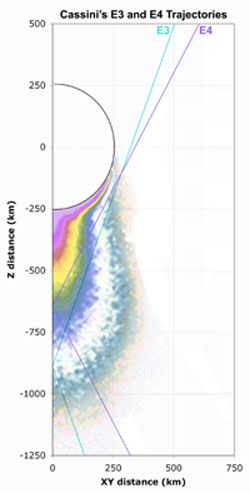 Shadan Ardalan, Cassini Navigator (bio)
Shadan Ardalan, Cassini Navigator (bio)
Good morning from sunny Southern California. I have literally been up all night waiting to hear back from the Cassini spacecraft after its closest ever flyby of Enceladus. It’s nights like this that I feel like a kid again waiting up for Santa on Christmas Eve.
As you know from all the other blog posts, last night we skimmed above the surface of Enceladus at an altitude of 82,000 feet (nearly 16 miles) while traveling at about 40,000 miles per hour…..and as if that wasn’t cool enough, we gave Cassini a “cosmic car wash” by flying the spacecraft through the plumes of the geysers on Enceladus.
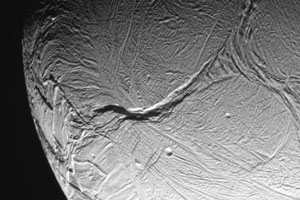 The challenge of navigating a spacecraft with the precision required for such a feat is two-fold. Not only do my navigation teammates need to determine the orbit of the Cassini spacecraft (i.e., where it is and where it’s going), but there are other members of the navigation team trying to better figure out where Enceladus is (it’s one thing to know where you are….it’s something entirely different to know where your target is). The experience from the other two Enceladus close encounters earlier this past March and August has improved our knowledge of this moon to such a degree that we feel confident that we can hit this tighter bullseye nearly a billion miles away from Earth.
The challenge of navigating a spacecraft with the precision required for such a feat is two-fold. Not only do my navigation teammates need to determine the orbit of the Cassini spacecraft (i.e., where it is and where it’s going), but there are other members of the navigation team trying to better figure out where Enceladus is (it’s one thing to know where you are….it’s something entirely different to know where your target is). The experience from the other two Enceladus close encounters earlier this past March and August has improved our knowledge of this moon to such a degree that we feel confident that we can hit this tighter bullseye nearly a billion miles away from Earth.
Fans of extreme sports would especially appreciate what we accomplished. I’ve bungee-cord dropped before and tonight’s flyby kinda reminded me of that. This flyby 82,000 feet above the surface and through the plume of water ice is like bungee-cord jumping off a bridge and dipping your head into the river below before getting sprung back up.
As I’m anxiously waiting to receive a signal from the spacecraft, I’ve been spending my time surfing the web to see what the world has to say about us. One of the coolest aspects of working on such a historic mission as Cassini is reading stories on our work in the media.
As I’ve been typing this blog entry (and doing a little more net-surfing), I’ve been monitoring the real-time doppler signal, waiting for a call back home just to tell me everything is all-right. AND THERE IT IS – YIPPEE!!!!!! and WHEEW!!!!! (wiping sweat off of brow). This signal tells me in real-time, that Cassini successfully flew by Enceladus. My friends will process this signal later this morning to tell us how well we hit our target.
And like that kid who just heard Santa land on his rooftop, I best be off to bed because I know when I wake up later this morning, I will have great gifts waiting for me in the form of spectacular images—I can hardly wait!!!!
I have pasted one raw image from the flyby here.To view all the latest images from before closest approach and as the spacecraft sped away from Enceladus, go to:
http://saturn.jpl.nasa.gov/multimedia/images/raw/index.cfm
and click on browse latest images.
–Shadan

 Sascha Kempf
Sascha Kempf  Amanda Hendrix
Amanda Hendrix Now, this flyby has a similar trajectory to the previous two flybys in March and August: a fast, inclined path coming in over the northern hemisphere and leaving over the southern hemisphere, with closest approach at a low latitude. Recall that summer in the southern hemisphere is winding down, meaning that the active “tiger stripe” region is illuminated by the sun less and less every day. CIRS and RADAR can see in the dark and don’t care too much about solar illumination, but ISS, UVIS and VIMS usually measure solar light reflected from the surface—so opportunities to measure the wild south pole using these methods are dwindling!
Now, this flyby has a similar trajectory to the previous two flybys in March and August: a fast, inclined path coming in over the northern hemisphere and leaving over the southern hemisphere, with closest approach at a low latitude. Recall that summer in the southern hemisphere is winding down, meaning that the active “tiger stripe” region is illuminated by the sun less and less every day. CIRS and RADAR can see in the dark and don’t care too much about solar illumination, but ISS, UVIS and VIMS usually measure solar light reflected from the surface—so opportunities to measure the wild south pole using these methods are dwindling!  Geraint Jones
Geraint Jones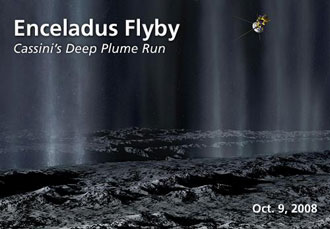 The results from each of this year’s Enceladus flybys has a different flavor. The main reason for this is that not all instruments can be pointed in their respective “best” directions at once, and the flybys are so brief that there’s no time to turn Cassini, so every instrument gets a good look or samples the particles they want to… it’s a bit like deciding who gets the window and aisle seats! Luckily, because we’ve got several flybys, the teams can take it in turns to get the best data out of their respective experiments… this time, as it was back on March 12th, the MAPS instrument teams are in their favorite seats.
The results from each of this year’s Enceladus flybys has a different flavor. The main reason for this is that not all instruments can be pointed in their respective “best” directions at once, and the flybys are so brief that there’s no time to turn Cassini, so every instrument gets a good look or samples the particles they want to… it’s a bit like deciding who gets the window and aisle seats! Luckily, because we’ve got several flybys, the teams can take it in turns to get the best data out of their respective experiments… this time, as it was back on March 12th, the MAPS instrument teams are in their favorite seats. Todd Barber
Todd Barber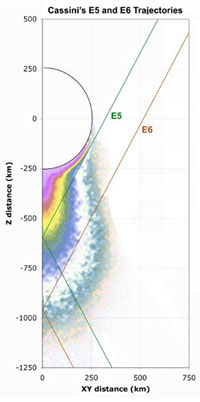 Given this truly up-close-and-personal flyby, the primary scientific focus will be “sniffing” the tenuous atmosphere of Enceladus, a rarefied collection of gas and dust spewed forth from a surprisingly active surface. As such, E5 will concentrate less on imaging results, but E6 will tip the scales towards imaging yet again, all before the end of the month. Truly, Cassini is embarking on a busy October for the ages!
Given this truly up-close-and-personal flyby, the primary scientific focus will be “sniffing” the tenuous atmosphere of Enceladus, a rarefied collection of gas and dust spewed forth from a surprisingly active surface. As such, E5 will concentrate less on imaging results, but E6 will tip the scales towards imaging yet again, all before the end of the month. Truly, Cassini is embarking on a busy October for the ages!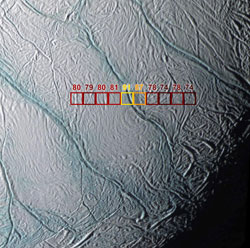
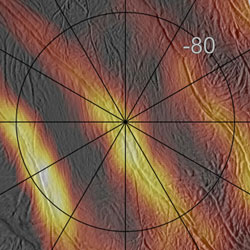 Image left: Heat radiation from tiger stripes.
Image left: Heat radiation from tiger stripes.  Todd Barber,
Todd Barber, 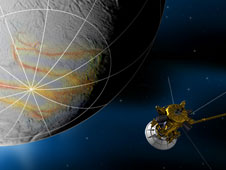 Speaking of propellant usage, there have been some questions about how
Speaking of propellant usage, there have been some questions about how  Todd Barber
Todd Barber 